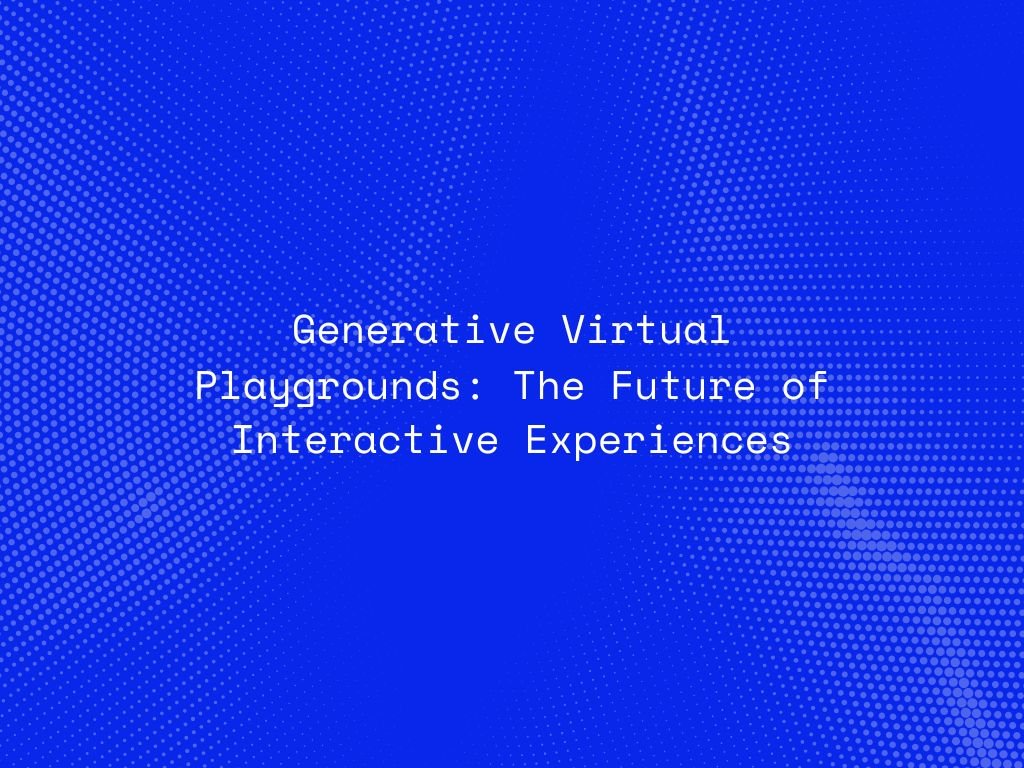As generative AI continues to evolve, its influence is rapidly extending beyond static content creation into dynamic, real-time environments. One of the most promising and exciting frontiers lies in generative virtual playgrounds—immersive, AI-driven spaces where users are not just passive consumers but active participants in evolving digital experiences.
From gaming and education to virtual collaboration and therapy, these interactive environments are transforming how we engage with digital content. They represent a future where human creativity and artificial intelligence intersect to co-create endlessly adaptive, responsive, and personalized experiences.
What Are Generative Virtual Playgrounds?
Generative virtual playgrounds are digitally constructed, AI-powered environments that allow users to explore, build, interact, and learn through real-time generative technologies. Unlike traditional pre-scripted virtual worlds, these playgrounds are:
-
Dynamic: Content, rules, and visuals can evolve as users engage.
-
Personalized: Environments adapt based on individual preferences, behavior, and learning styles.
-
Collaborative: Multiple users can interact, co-create, and experience emergent outcomes together.
At the heart of these playgrounds lies generative AI, which crafts experiences by interpreting user input, modeling behavior, and synthesizing content—from landscapes and stories to avatars and dialogue.
Applications Across Domains
1. Gaming and Entertainment
Gaming has been a natural early adopter of generative playgrounds. AI-driven environments now allow for:
-
Endless world generation (e.g., procedurally generated maps or narratives)
-
Player-personalized storylines
-
Real-time NPC behavior adaptation
-
Evolving game mechanics based on user skill level and decisions
This transforms gaming from a linear, designer-driven experience into a co-creative, emergent adventure.
2. Education and Training
Virtual playgrounds powered by AI are enabling adaptive learning platforms where:
-
Lessons and environments change based on real-time student interaction
-
Gamified learning adapts to individual pace and comprehension
-
Immersive role-playing enhances memory retention and understanding
In simulations for fields like medicine or aviation, these environments provide safe, realistic, and constantly evolving training grounds.
3. Virtual Collaboration and Workspaces
Remote work and digital collaboration benefit from AI-generated virtual spaces that:
-
Automatically adjust layouts based on team behavior
-
Facilitate non-verbal interaction using avatars and expressions
-
Provide on-demand generative tools (e.g., whiteboards, 3D modelers, real-time document drafting)
These playgrounds support creativity and team productivity, especially in design, engineering, and product innovation.
4. Therapy and Mental Health
Interactive AI environments are also being used in therapy for:
-
Exposure therapy in virtual but controlled scenarios
-
Emotional support via generative avatars
-
Mindfulness and relaxation experiences tailored in real time
These experiences are emotionally intelligent, adjusting tone, difficulty, or ambiance based on biometric and behavioral feedback.

Key Technologies Enabling These Playgrounds
Several technological pillars support the rise of generative virtual playgrounds:
-
Large Language Models (LLMs): For generating dialogue, narratives, and instructions.
-
Procedural Generation Algorithms: To build diverse and complex digital terrains or scenarios on the fly.
-
Reinforcement Learning: To allow agents and environments to learn from user interactions and improve.
-
Natural Language Processing (NLP): To enable intuitive communication and interaction with virtual agents.
-
3D Generative Models (like Sora or NVIDIA’s GET3D): For creating realistic characters, assets, and environments.
Benefits for the Future
Generative virtual playgrounds offer several transformative benefits:
-
Immersion & Engagement: Real-time responsiveness makes experiences more lifelike and emotionally engaging.
-
Cost Efficiency: Automated content generation reduces manual effort in design and development.
-
Scalability: Experiences can be scaled to millions of users while maintaining personalization.
-
Accessibility: Adaptive learning and interaction lower the barriers for people with diverse needs.
Challenges and Considerations
As exciting as this evolution is, it comes with important challenges:
-
Content Moderation: Generative environments can create unpredictable or inappropriate outcomes.
-
Ethical Concerns: Use of AI for personalization must respect user privacy and data rights.
-
Technical Complexity: Creating stable, real-time generative systems at scale requires advanced infrastructure.
-
Addiction and Overuse: Especially in gaming or therapy contexts, constant immersion can lead to dependency or reduced real-world engagement.
What’s Next?
The future of generative virtual playgrounds lies in multimodal interaction—where AI not only generates text or visuals but also synchronizes sound, gestures, and spatial intelligence. We’ll see:
-
AI companions that evolve with you across platforms
-
Collaborative design tools that work as creative partners
-
Virtual worlds that reflect your mood, goals, and imagination
Eventually, the line between reality and simulation will blur, creating experiences that are not only interactive but deeply personal, emotionally intelligent, and creatively infinite.
Conclusion
Generative virtual playgrounds represent a paradigm shift in how we interact with technology. They’re not games, apps, or platforms in the traditional sense—they’re living digital ecosystems, co-created by humans and AI.
As these systems mature, they’ll redefine engagement in education, work, therapy, entertainment, and more. The future is not about consuming static content—it’s about participating in living, learning, and evolving environments shaped by artificial intelligence and human imagination.




